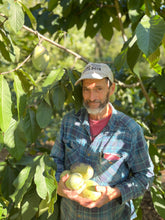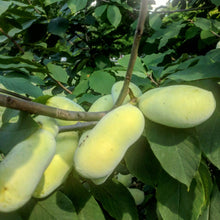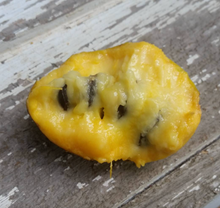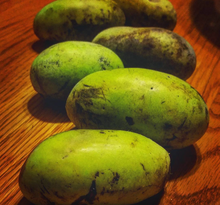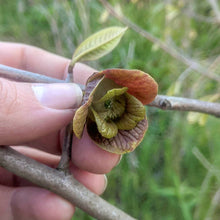C. Dale's Pawpaw Breeding Mix
Regular price
$5.00
Sale
Asimina triloba
Origin: SE Pennsylvania
Improvement status: Mix of wild and grafted cultivars
Seeds per packet:
5 seeds for $5 ($1 each)
20 seeds for $12 ($0.60 each)
BOTANICAL SAMPLE - NOT GERMINATION TESTED
Life cycle: Perennial
Pawpaw is the largest fruit native to the continental US. A member of the custard apple (Annonaceae) family — and the only fully cold hardy one — nearly all of its cousins are fully tropical (though southeastern US, especially Florida, is home to quite a few different species of pawpaw). It is an intrepid explorer from the tropics that somehow made a home for itself in the frigid north — amazingly, there even exist populations in southern Ontario, Canada! It may be far from its ancestral home, but it is still essentially a tropical fruit, so it's no surprise that many say it tastes like banana or mango custard. Pawpaws like to grow in bright edges from half sun to three quarters sun, but will bear better the more sun they have — and they can handle full sun, so long as they're protected when they're young.
Typically found in the wild as an understory species, they will usually grow to just 20 feet or so, but when given an opening in the canopy, they might reach to 40 feet or even taller. After becoming well established, in say five years, pawpaws will begin suckering, spreading by their roots and forming colonies. They are self-infertile, so you need at least two plants (or better yet three or four) for good pollination and fruit-set. All trees can bear fruit though. Their inconspicious flowers are dark burgundy on the inside, the better to evoke the same rotting meat they mimic with their scent in order to appeal to the flies that pollinate them.
It's best to enjoy pawpaws fresh or frozen or brewed into some sort of beverage, unless you're willing to take a bit of a risk: Cooking or drying pawpaws can yield delicious food, but a small percentage of people are made swiftly and violently ill from consuming cooked or dried pawpaws (EFN co-founder Dusty Hinz is one such person, a fact he discovered after a pawpaw corn muffin had an emetic effect on him just seconds after consuming it; Nate has eaten cooked pawpaw on multiple occasions with no issues). We have really enjoyed some amazing pawpaw ice cream, kombucha, and wine over the past few years.
These seeds come from our good friend C. Dale Hendricks, of Landenburg, PA. This selection of seeds comes from his home patch and includes several local wild-type plants along with many improved varieties growing on grafted trees, including "Rappahanock" and "Susquehanna." They should yield some really nice new cultivars. Please let us know if you get any particular great ones!
GROWING TIPS: The seeds should not be allowed to dry out! This will kill nearly all of them. After storing in damp sand or peat in the refrigerator for the winter, it’s recommended to plant the seeds outside, water them in very well, and carefully mark their spot. They take their time germinating — often not popping until June or even — and the young plants can be quite small and inconspicuous, so easy to miss among weeds. It should take 6-7 years from seed to flowering and fruiting. Hardy in USDA zones 4-8.






